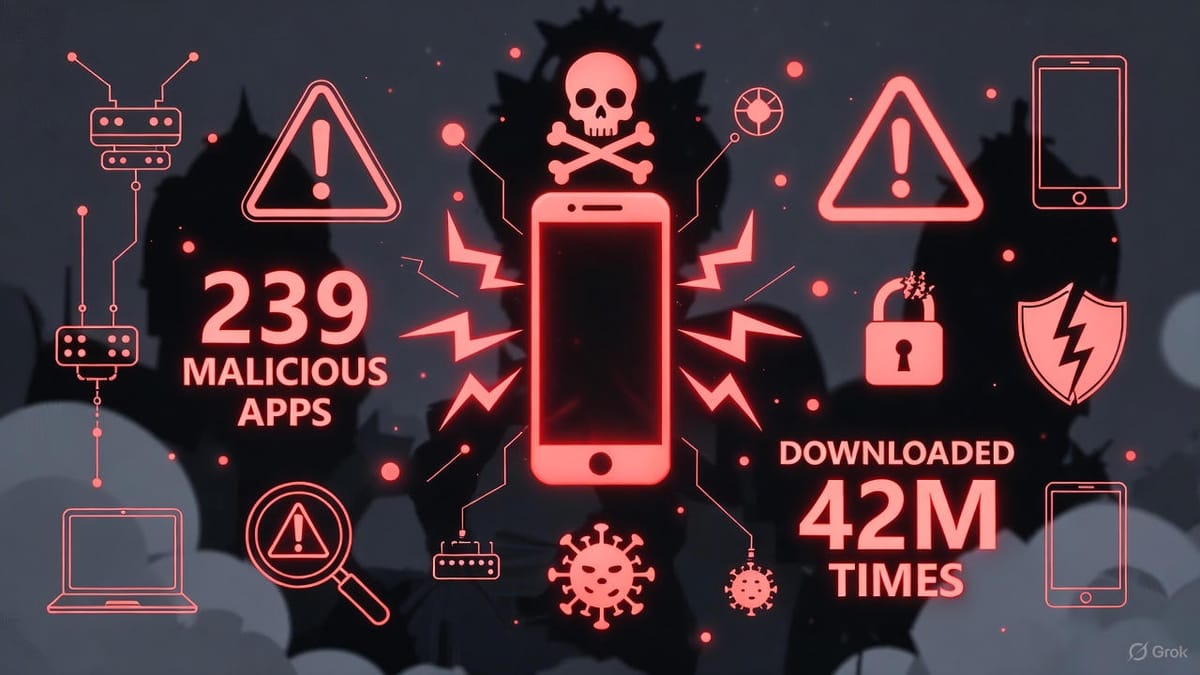Android malware surge, AI prompt injection, and botnet infiltration underscore evolving cyber threats

TL;DR
- Android Malware Surge: 239 Malicious Apps Downloaded 42 million Times in 2024–2025, Threatening Mobile Security.
- AI Prompt Injection Threat Continues to Escalate as Adversaries Deploy LLM-Driven Exploits Across Enterprise Environments.
- Darkweb Botnet Aisuru Wields Botnet Domains to Infiltrate Major Corporations, Upending Traditional Security Posture.
Android Malware Surge: Data‑Driven Outlook
Threat Scale (June 2024 – May 2025)
- 42 million+ malicious Android app downloads across 239 distinct packages.
- Average downloads per malicious app ≈ 176 k.
- Year‑over‑year growth in malware‑related transactions + 67 %.
- Adware accounts for 69 % of detections – roughly a two‑fold increase YoY.
- Banking‑trojan transactions total 4.89 million (down from a 29 % YoY share).
- Geographic concentration: United States 57 %, Canada 15 %, India 26 % (combined > 55 % of attacks).
Pattern Shifts
- Adware now eclipses traditional banking trojans, indicating a pivot toward click‑fraud revenue models.
- Industry‑specific payloads emerge: XNotice targets oil‑&‑gas recruitment portals; Void exploits TV‑box update mechanisms.
- Advanced evasion techniques – Accessibility Service abuse, zero‑click RCE (CVE‑2025‑48593) – extend dwell time.
- Modular C2 channels (e.g., SesameOp leveraging OpenAI Assistants API) bypass conventional network monitoring.
- Google Play Protect blocked 400 k+ malicious packages, yet the remainder reached end‑users, exposing static analysis limits.
- MDM policies remain inconsistently applied, especially on BYOD devices in remote‑work settings.
Emerging Trends
- Adware monetization surge drives a higher proportion of ad‑fraud traffic.
- Targeted mobile trojans expand into niche supply chains, increasing sector‑specific risk.
- Zero‑click exploits in core Android (AOSP 13‑16) create long‑term botnet assets when patching lags.
- Fragmented OS landscape – > 50 % of devices run unsupported Android versions – sustains infection reservoirs.
12‑Month Forecast
- Overall malicious download volume projected to reach ≈ 70 million by May 2026.
- Adware detections expected to comprise ~ 80 % of Android malware cases.
- Banking‑trojan transactions forecast to fall below 2 million.
- Geographic share from US/Canada/India likely to exceed 60 % of total downloads.
- Patch adoption for CVE‑2025‑48593 anticipated at ~ 45 % within six months, reflecting historical OEM lag.
Actionable Recommendations
- Integrate dynamic sandbox analysis into Play‑Store vetting; flag apps requesting Accessibility or overlay permissions for manual review.
- Enforce MDM controls that prohibit sideloading and mandate automatic security‑patch enforcement aligned with OS version compliance.
- Expand endpoint threat‑intel signatures to include industry‑specific families such as XNotice and Void; share IOCs through sector ISACs.
- Adopt delta‑OTA update mechanisms to accelerate patch distribution for legacy devices; prioritize OTA for Android 10+ devices.
- Conduct user‑awareness campaigns focused on permission scrutiny, especially for overlay and accessibility services, and promote verification of developer reputation before download.
Escalating Prompt‑Injection Threats Demand AI‑Aware Zero‑Trust
Rapid Expansion of the Threat Landscape
- Google Cloud’s 2026 Cybersecurity Forecast flags AI‑enabled prompt injection as a top‑growth vector, projecting record‑high attack volumes next year.
- GTIG’s white‑paper documents new families—PromptFlux, PromptSteal, QuietVault, FruitShell—leveraging Gemini’s “Thinking Robot” module for adaptive code generation.
- OpenAI disclosed seven critical GPT‑4o/GPT‑5 vulnerabilities; 250 poisoned documents can embed backdoors in models from 600 M to 13 B parameters (CVSS 9.6 for CamoLeak exfiltration).
- IDC predicts 1.3 billion AI agents in circulation by 2028, underscoring the imminent scale of exposure.
Malware Families Turning LLMs Into Live Code Generators
- PromptFlux (Gemini) – Obfuscated VBScript that queries Gemini for payload updates, evading static signatures.
- PromptSteal (Qwen) – Executes AI‑crafted CLI commands to harvest Windows and Linux credentials, masking traffic as legitimate API calls.
- QuietVault (Internal LLM) – Uses AI‑generated prompts to bypass endpoint detection and encrypt exfiltrated data.
- Herodotus (Claude) – Automates natural‑language reconnaissance, delivering LLM‑written ransom notes across 17 organizations.
All share a prompt‑injection loop: a malicious prompt triggers an LLM, the model returns executable instructions, and the malware runs them autonomously. Signature‑based defenses crumble as each iteration mutates the code.
Vulnerability Hotspots Across Major Platforms
- Training‑data poisoning enables backdoors with minimal effort.
- Memory injection embeds hidden prompts in markdown, persisting across ChatGPT sessions.
- CamoLeak (CVSS 9.6) exfiltrates data via Microsoft 365 Copilot Chat, evading DLP alerts.
- LatentBreak creates low‑perplexity adversarial prompts that slip past content filters.
Emerging Defensive Controls
- Agentic SOC – AI agents automate triage, hypothesis validation, and policy generation within minutes.
- Model Context Protocol (MCP) servers – Sandbox inference contexts, restricting LLM outbound calls to authorized endpoints.
- AI‑Zero‑Trust – Verifies identity for every AI‑generated request, limiting shadow‑agent exposure.
- Real‑time AI usage visibility platforms now log >15 k AI‑related detections daily, correlating model calls with endpoint behavior.
- Clean‑room fine‑tuning pipelines scan training corpora for malicious signatures, mitigating poisoning risk.
Forecasts Shaping 2026 and Beyond
- Prompt‑injection incidents expected to rise 28 % YoY through 2026, driven by enterprise LLM adoption.
- State‑sponsored campaigns from China, Iran, and North Korea could account for >45 % of detected malware.
- Underground marketplaces may list >120 AI‑malware toolkits by Q2 2026, with pricing dropping 12 % as reuse expands.
- Organizations deploying MCP and AI‑Zero‑Trust before Q4 2026 could cut exploitation latency from hours to under 30 minutes.
Why Immediate Action Is Critical
The convergence of generative AI, mutable prompt‑injection techniques, and sprawling enterprise LLM deployments creates a high‑velocity attack surface where traditional defenses fail. Deploying AI‑aware Zero‑Trust controls, sandboxed inference contexts, and continuous AI activity monitoring is no longer optional—it is the frontline defense against a wave of sophisticated, self‑evolving threats.
Darkweb Botnet Aisuru Exploits Cloud DNS Rankings
Threat Overview
- Botnet‑controlled domains repeatedly entered Cloudflare’s “Top Sites” list, displacing services from Amazon, Apple, Google, and Microsoft.
- Since early October 2025 the botnet redirected DNS queries to Cloudflare resolvers (1.1.1.1 & 1.1.2.1), inflating query counts for malicious domains.
- Rankings based solely on query frequency were corrupted, weakening security controls that rely on popularity signals.
- Key contributors: Alex Greenland (Epi) explained ranking mechanics; Renee Burton challenged the distortion magnitude.
Chronological Timeline
- Early Oct 2025 – Aisuru begins routing recursive DNS queries to Cloudflare resolvers, starting volume inflation.
- 4 Nov 2025 – Social‑media monitoring flags a surge in queries for Aisuru‑controlled domains.
- 6 Nov 2025 – Cloudflare removes affected domains from public lists and releases statements from Greenland and Burton.
- Post‑6 Nov 2025 – Cloudflare announces a ranking‑algorithm redesign incorporating entropy filters and cross‑source validation.
Botnet Mechanics
- Bulk domain registration with fast‑flux IP pools; domains rotate weekly to evade blacklist updates.
- Infected devices (estimated > 200 M) generate recursive queries, producing “organic” traffic interpreted as legitimate popularity.
- Resolved domains host C2 beacons, downloader stagers, or credential‑stealing scripts targeting cloud‑admin interfaces.
- Placement in Top Sites grants implicit trust from security products that whitelist popular domains.
Impact on Cloud Providers
- Inbound traffic from Aisuru domains increased for AWS, Azure, and Google Cloud, raising phishing and credential‑theft risk.
- Traditional DNS blacklists missed Aisuru domains due to temporary “benign” classification by the ranking engine.
- Infoblox reported a 12 % rise in suspicious DNS queries related to the affected providers during the reporting window.
- Increased surface area for credential‑stealing payloads delivered via compromised domains.
Macro‑Trend Context
- Automated agents generated 51 % of 2024 internet traffic; 37 % of that traffic identified as “bad bots.”
- Generative‑AI tools lowered the barrier for bot creation, accelerating domain‑generation scripts used by Aisuru.
- Advanced or moderate bots featured in 55 % of 2024 attacks, matching Aisuru’s fast‑flux infrastructure.
- These trends explain the scalability of DNS‑based botnet abuse.
Security Posture Implications
- Popularity‑based rankings no longer provide reliable DNS trust decisions.
- Bot‑origin traffic can pollute telemetry pipelines, creating false allowances.
- DNS query spikes should be treated as compromise indicators, not solely as load‑balancing events.
- Cloud providers must adopt multi‑dimensional analysis of DNS activity.
Recommended Counter‑Measures
- Deploy entropy‑enhanced DNS analytics that examine query source diversity, geographic dispersion, and response latency.
- Integrate real‑time threat‑intel feeds that flag high‑volume resolver logs, independent of ranking status.
- Enforce strict API credential rotation for cloud‑admin interfaces and monitor anomalous logins from newly‑registered domains.
- Conduct regular red‑team exercises focused on DNS‑based lateral movement and fast‑flux scenarios.
Near‑Term Outlook
- Resolver operators will adopt multi‑dimensional scoring (entropy, client reputation, temporal variance) to harden rankings.
- Aisuru is expected to shift toward DNS over HTTPS and other transport layers to bypass resolver‑side filters.
- Regulatory bodies may issue guidelines on the use of popularity‑based security controls.
- Continued monitoring of DNS query patterns will be essential to detect evolving botnet tactics.



Comments ()